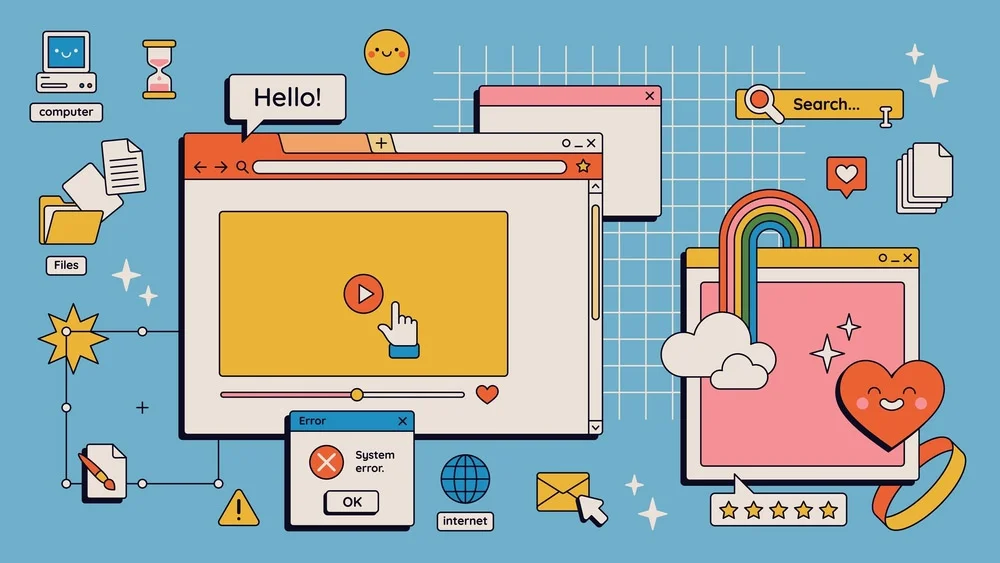The Ultimate Guide to The Best UX/UI App Design
In today’s digital landscape, it is no surprise that everything is digitalized and enhanced. This is something that makes it necessary to design an intuitive app and increase its engagement through enhanced user interfaces. Additionally, optimize user experiences in order to help the app succeed and work efficiently. This guide aims to highlight for you the best UX/UI app design. Additionally, learn how to reach such a level of success when it comes to launching your app. Delve with me into the depths of this topic and understand the fundamental principles of UX/UI app design. Our guide will help you explore topics such as user research, wireframing, prototyping, usability testing, and iterative design processes.
You’ll learn how to create interfaces that resonate with your audience and drive meaningful engagement. That is, by understanding user behaviors, preferences, and pain points. This is the era where innovation and user-centricity collide. To create exceptional digital experiences. Let us uncover the latest trends and practices that will help you shape the best UX/UI app design. That is through responsive design, micro-interactions, accessibility, and the integration of emerging technologies. Ones like artificial intelligence and augmented reality. The purpose of this guide is to provide you with actionable insights. Moreover, we will provide you with practical suggestions that will improve your design skills. Additionally, produce user experiences that are unsurpassed, regardless of whether you are an experienced professional or a rookie in the area.
What Is a UX/UI App Design? A Quick Overview of What User Experience (UX) Is
UX/UI app design is a reference to the process of creating user interfaces for applications that are digital. This process focuses on enhancing the design principles of the user experience (UX) and user interface (UI). You know in Supernatural the series when there is no Sam without Dean in anything? Have you seen how both Winchester brothers empower each other to form a team of invincible ghost hunters? This is exactly the same, apart from the “saving people, hunting things, the family business!” part, of course.
All jokes aside, unified user experience design helps create an emphasis on understanding user behaviors, demands, and motivations. That is, in order to guarantee that the application is several things. Such as being user-friendly, simple to operate, and enjoyable for the user. In order to accomplish this, you must conduct user research, develop user personas, and design user flows and wireframes. That is, in order to map out the user journey within the application. When it comes to a communication or messaging app like WhatsApp, for instance, user experience design ensures or makes sure that users are able to simply browse between conversations, send messages, and maintain their contacts.
UX/UI App Design: User Interface (UI) Is a Whole Other Thing, Related, But Different
On the other hand, if we look at the user interface, or UI, we will find that it aims to enhance the visual aspects of the application. That includes designing and enhancing several things in your app. Like the layout, colors, font, and interactive components, with the goal of developing interfaces that are visually appealing and consistent. It’s like giving an empty canvas to a painter and telling them, “Get creative and shape it as you wish.” Both user interface designers and user experience designers collaborate closely to ensure that the visual design accurately reflects the overall user experience goals. These are two of the most important aspects of app development that you should focus on.
Take Strava’s UI into consideration as an excellent UI example. This is an app where clear icons represent different activities. Such as running, cycling, or swimming. The navigation menu offers straightforward options for tracking workouts, viewing progress, and connecting with friends. Visual cues like progress bars and achievement badges provide motivation and feedback to users, enhancing engagement. Let me walk you through another hypothetical example here. In a banking app, for example, UI design ensures that users can easily navigate their way. That is, between account balances, transfer funds, and view transaction history through intuitive icons and clear menu structures. Consistent use of color schemes and typography enhances readability, while prominent call-to-action buttons facilitate seamless interactions for users managing their finances.
What Are The Elements of User Experience (UX)?
Okay, now that we’re beyond defining both developmental aspects, let us dive deeper into each one of them. The components or elements of each one of them are what you enhance or work on. It is important that you know each one of them. That is, in order to understand what needs enhancing in your app and start on upgrading and designing it. The following are the most essential components of user experience or UX app design:.
Top Components of User Experience (UX):

- User Research: Utilizing techniques such as interviews, questionnaires, and usability testing, user research is an essential component of user experience design (UX design). For the purpose of informing design decisions, it seeks to get an understanding of user behaviors, needs, and preferences. In order to make sure that interfaces meet user expectations, designers refine them through the process of evaluating input and observing interactions, which ultimately produces intuitive and satisfying experiences.
- Prototyping and Wireframes: The purpose of wireframes in user experience design is to serve as skeletal blueprints that outline app layouts and functionality, with a particular emphasis on structure and data placement. Wireframes are brought to life through the process of prototyping, which enables designers to develop interactive models for the purpose of user testing and feedback. The design process is streamlined as a result of their combined efforts, which include assuring user-centric interfaces and easy navigation.
- Architecture of Information: When it comes to user experience design, the Architecture of Information component is responsible for organizing and structuring content in order to maximize user comprehension and navigation. Creating navigation paths that are easy to understand, categorizing information in a logical manner, and clearly labeling information are all required. For example, the menu bar of a website is able to effectively route people to the areas that are relevant to their needs, simplifying their browsing experience and improving the website’s usability.
UX/UI App Design: Additional Components That You Should Learn and Know About
- Interactive and Visual Design: User experience (UX) design places a significant emphasis. One that is on the role that interactive and visual components have in attracting and retaining users. The digital environment provides users with a sense of immersion and empowerment. By means of user interfaces that are easy to understand, animations that are dynamic, and feedback that is responsive. These components improve usability, orient navigation, and provide memorable interactions. All of which contribute to the development of positive user experiences.
- Accessibility: Adding accessibility components guarantees that everyone will have a positive and user-friendly experience. That is, when it comes to user experience design. Users who have visual impairments, for instance, can benefit from the provision of alternative text for images. Moreover, users who use screen readers can benefit from a heading structure that is thoughtfully ordered. The incorporation of these components results in a design that is accessible to all users. Which in turn promotes an inclusive digital environment.
The Main Components of User Interface (UI):
- Screen Layout: The layout of the screen in a messaging app, for example, normally consists of a list of conversations on the left side of the screen and a chat window on the right side of the screen. In many cases, the icons that allow users to compose messages, search, and access settings are situated at the very top of the screen. The UI places an emphasis on the simplicity of accessing conversations and user-friendly messaging functions throughout.
- Screen and Touch Interactions: When it comes to user interface design, screen and touch interactions involve the creation of motions that are easy to understand and apply so that people may navigate through digital devices with ease. The incorporation of responsive components, such as swipe movements for scrolling, tap actions for selection, and pinch-to-zoom for detail, improves user engagement and interaction fluidity, hence enhancing the user experience across a variety of devices.
- Navigation: In user interface design, navigation is responsible for orchestrating seamless user journeys through the utilization of user-friendly menu structures, breadcrumbs, and navigation bars. Clear labeling and a hierarchical structure guide users through the interface, making it more accessible and lowering the cognitive load. Through the use of responsive design, navigation can be adapted to work across different devices, resulting in experiences that are consistent and user-friendly across all platforms.
- Imagery and Icons: The use of imagery and iconography in user interface design acts as visual anchors, facilitating the effective transmission of information and increasing user engagement. Icons that have been thoughtfully created offer navigational clues that are easy to understand, while imagery injects context and personality into user interfaces. By maintaining a consistent style and iconography, users are guaranteed to be able to immediately perceive and interact with the interface without any difficulty.
Additional User Interface UI Elements and Components:
- Your App’s Typography: When it comes to user interface design, typography plays an important part because it efficiently conveys information and improves the user experience. Font weights and styles that are appropriate facilitate hierarchy and organization while easy-to-read and legible typefaces improve readability. Maintaining visual harmony and providing a professional and unified appearance for the user interface can be accomplished by using typography that is consistent throughout the interface.
- Your App’s Consistency: When it comes to user interface design, consistency guarantees that the user experience is consistent and predictable across an application. The maintenance of a unified visual language, the standardization of navigation components, and the consistent utilization of colors, typography, and icons are all tasks involved. Because of this consistency, user interactions are simplified, cognitive burden is reduced, and a sense of familiarity is fostered, all of which contribute to an overall improvement in usability.
- Animation and App Gestures: The use of animation in user interface design provides consumers with feedback and guides them through transitions, adding depth and interactivity to the design. By streamlining user interactions and making navigation more simple and efficient, app gestures like swiping, pinching, and tapping are becoming increasingly popular. Well-designed animation and gestures create engaging and memorable interactions within the app, which enhances the entire user experience.
Final Thoughts!
Now that you know the meaning, importance and elements of UX/UI app design, let me tell you the importance of developing an app for your business. An app can empower your business in many ways. It can increase your business visibility, exposure, and the way you reach potential clients, users, or customers. It also streamlines your operations and daily tasks in a very efficient way.
That is why nandbox, offers you the perfect app builder that you can use to create your own fully functional, no-code app. With our simple drag-and-drop interface, you’ll find yourself building an app with no hassles and in a matter of minutes. Sign up now and don’t miss the chance to take your business to the next level of success with an app you create with the number one native app builder in the market!






